The Fuel Cycle Carbon Reduction Effects of New Energy Vehicles: Empirical Evidence Based on Regional Data in China
Abstract
:1. Introduction
2. Data and Methodology
2.1. Data
2.2. Methodology
2.2.1. Fuel Cycle Carbon Reduction Effects
2.2.2. Forecast of NEVs
3. Results and Discussion
3.1. Fuel Cycle Carbon Reduction Effects
3.2. Carbon Reduction Prediction
4. Policy Implications
- (1)
- Maintaining policy support in the current diffusion stage:
- (2)
- Improving R&D investment to promote the technological advancement of core components:
- (3)
- Enhancing the corresponding infrastructure:
- (4)
- Tailoring NEV promotion policies for different regions:
- (5)
- Phasing out thermal power generation to improve the cleanliness of the power structure:
5. Conclusions
Author Contributions
Funding
Institutional Review Board Statement
Informed Consent Statement
Data Availability Statement
Conflicts of Interest
References
- The International Panel on Climate Change (IPCC). The Evidence Is Clear: The Time for Action Is Now. We Can Halve Emissions by 2030. Available online: https://www.ipcc.ch/2022/04/04/ipcc-ar6-wgiii-pressrelease/ (accessed on 26 September 2022).
- International Energy Agency (IEA). Net Zero by 2050: A Roadmap for the Global Energy Sector. Available online: https://iea.blob.core.windows.net/assets/deebef5d-0c34-4539-9d0c-10b13d840027/NetZeroby2050-ARoadmapfortheGlobalEnergySector_CORR.pdf (accessed on 23 August 2022).
- Grubler, A.; Wilson, C.; Bento, N.; Boza-Kiss, B.; Krey, V.; McCollum, D.L.; Rao, N.D.; Riahi, K.; Rogelj, J.; De Stercke, S.; et al. A low energy demand scenario for meeting the 1.5 °C target and sustainable development goals without negative emission technologies. Nat. Energy 2018, 3, 515–527. [Google Scholar] [CrossRef] [Green Version]
- Guilyardi, E.; Lescarmontier, L.; Matthews, R.; Point, S.P.; Rumjaun, A.B.; Schlüpmann, J.; Wilgenbus, D. IPCC Special Report “Global Warming of 1.5 °C”: Summary for Teachers. 2018. Available online: https://refubium.fu-berlin.de/bitstream/handle/fub188/25436/Guilyardi_IPCC_2018.pdf;jsessionid=7CCFD6217A786BF8EEE026D4B8A0ED59?sequence=1 (accessed on 26 September 2022).
- International Energy Agency (IEA). Global Energy Review 2021. 2021. Available online: https://iea.blob.core.windows.net/assets/d0031107-401d-4a2f-a48b-9eed19457335/GlobalEnergyReview2021.pdf (accessed on 17 August 2021).
- U.S. Department of Transportation. Electric Vehicle Types. Available online: https://www.transportation.gov/rural/ev/toolkit/ev-basics/vehicle-types (accessed on 15 September 2022).
- Moriarty, P.; Wang, S.J. Can electric vehicles deliver energy and carbon reductions? Energy Procedia 2017, 105, 2983–2988. [Google Scholar] [CrossRef] [Green Version]
- Yuan, X.; Liu, X.; Zuo, J. The development of new energy vehicles for a sustainable future: A review. Renew. Sustain. Energy Rev. 2015, 42, 298–305. [Google Scholar] [CrossRef]
- Helmers, E.; Marx, P. Electric cars: Technical characteristics and environmental impacts. Environ. Sci. Eur. 2012, 24, 14. [Google Scholar] [CrossRef] [Green Version]
- Su, C.-W.; Yuan, X.; Tao, R.; Umar, M. Can new energy vehicles help to achieve carbon neutrality targets? J. Environ. Manag. 2021, 297, 113348. [Google Scholar] [CrossRef] [PubMed]
- Ma, H.; Balthasar, F.; Tait, N.; Riera-Palou, X.; Harrison, A. A new comparison between the life cycle greenhouse gas emissions of battery electric vehicles and internal combustion vehicles. Energy Policy 2012, 44, 160–173. [Google Scholar] [CrossRef]
- Moro, A.; Helmers, E. A new hybrid method for reducing the gap between WTW and LCA in the carbon footprint assessment of electric vehicles. Int. J. Life Cycle Assess. 2015, 22, 4–14. [Google Scholar] [CrossRef] [Green Version]
- Jwa, K.; Lim, O. Comparative life cycle assessment of lithium-ion battery electric bus and Diesel bus from well to wheel. Energy Procedia 2018, 145, 223–227. [Google Scholar] [CrossRef]
- Campanari, S.; Manzolini, G.; de la Iglesia, F.G. Energy analysis of electric vehicles using batteries or fuel cells through well-to-wheel driving cycle simulations. J. Power Sources 2009, 186, 464–477. [Google Scholar] [CrossRef]
- International Energy Agency (IEA). Global CO2 Emissions Rebounded to Their Highest Level in History in 2021. Available online: https://www.iea.org/news/global-co2-emissions-rebounded-to-their-highest-level-in-history-in-2021 (accessed on 15 August 2022).
- Lin, B.; Shi, L. Do environmental quality and policy changes affect the evolution of consumers’ intentions to buy new energy vehicles. Appl. Energy 2022, 310, 118582. [Google Scholar] [CrossRef]
- Dong, F.; Liu, Y. Policy evolution and effect evaluation of new-energy vehicle industry in China. Resour. Policy 2020, 67, 101655. [Google Scholar] [CrossRef]
- Martínez-Lao, J.; Montoya, F.G.; Montoya, M.G.; Manzano-Agugliaro, F. Electric vehicles in Spain: An overview of charging systems. Renew. Sustain. Energy Rev. 2017, 77, 970–983. [Google Scholar] [CrossRef]
- Yi, T.; Zhang, C.; Lin, T.; Liu, J. Research on the spatial-temporal distribution of electric vehicle charging load demand: A case study in China. J. Clean. Prod. 2019, 242, 118457. [Google Scholar] [CrossRef]
- Rietmann, N.; Hügler, B.; Lieven, T. Forecasting the trajectory of electric vehicle sales and the consequences for worldwide CO2 emissions. J. Clean. Prod. 2020, 261, 121038. [Google Scholar] [CrossRef]
- Lee, D.-H.; Kim, M.-S.; Roh, J.-H.; Yang, J.-P.; Park, J.-B. Forecasting of Electric Vehicles Charging Pattern Using Bayesians method with the Convolustion. IFAC-PapersOnLine 2019, 52, 413–418. [Google Scholar] [CrossRef]
- Yuan, X.; Cai, Y. Forecasting the development trend of low emission vehicle technologies: Based on patent data. Technol. Forecast. Soc. Chang. 2021, 166, 120651. [Google Scholar] [CrossRef]
- Xi, J. In Proceedings of the General Assembly Seventy-Fifth Session 4th Plenary Meeting, New York, NY, USA, 22 September 2020; Available online: https://www.un.org/en/ga/info/meetings/76schedule.shtml (accessed on 30 November 2022).
- Gorner, M.; Paoli, L. How Global Electric Car Sales Defied COVID-19 in 2020. Available online: https://policycommons.net/artifacts/1427492/how-global-electric-car-sales-defied-covid-19-in-2020/2042243/ (accessed on 7 November 2022).
- Traffic Administration Bureau of the Ministry of Public Security (TABMPS). China’s NEV Stock 2021. Available online: http://www.gov.cn/fuwu/bm/jtysb/index.htm (accessed on 26 September 2022).
- Sun, F.C. New Energy Vehicle Big Data Research Report 2021, 1st ed.; China Machine Press: Beijing, China, 2021; pp. 67–143. [Google Scholar]
- NDANEV. New Energy Vehicle National Big Data Alliance Briefing 2021. Available online: http://www.ndanev.com/ (accessed on 10 August 2022).
- Huo, H.; Wang, M.; Zhang, X.; He, K.; Gong, H.; Jiang, K.; Jin, Y.; Shi, Y.; Yu, X. Projection of energy use and greenhouse gas emissions by motor vehicles in China: Policy options and impacts. Energy Policy 2011, 43, 37–48. [Google Scholar] [CrossRef]
- IPCC. IPCC Guidelines for National Greenhouse Gas Inventories (IGES); N.G.G.I. Programme, Ed.; IPCC: Geneva, Switzerland, 2006; Available online: https://www.ipcc.ch/report/2006-ipcc-guidelines-for-national-greenhouse-gas-inventories/ (accessed on 7 November 2022).
- Hao, X.; Yuan, Y.; Wang, H.; Ouyang, M. Plug-in hybrid electric vehicle utility factor in China cities: Influencing factors, empirical research, and energy and environmental application. eTransportation 2021, 10, 100138. [Google Scholar] [CrossRef]
- Bass, F.M. A New Product Growth for Model Consumer Durables. Manag. Sci. 1969, 15, 215–227. [Google Scholar] [CrossRef]
- Bass, F.M.; Krishnan, T.V.; Jain, D.C. Why the bass model fits without decision variables. Mark. Sci. 1994, 13, 203–223. [Google Scholar] [CrossRef]
- Manoharan, Y.; Hosseini, S.E.; Butler, B.; Alzhahrani, H.; Senior, B.T.F.; Ashuri, T.; Krohn, J. Hydrogen fuel cell vehicles; current status and future prospect. Appl. Sci. 2019, 9, 2296. [Google Scholar] [CrossRef] [Green Version]
- Ahmadi, P.; Khoshnevisan, A. Dynamic simulation and lifecycle assessment of hydrogen fuel cell electric vehicles considering various hydrogen production methods. Int. J. Hydrog. Energy 2022, 47, 26758–26769. [Google Scholar] [CrossRef]
- Ren, L.; Zhou, S.; Ou, X. Life-cycle energy consumption and greenhouse-gas emissions of hydrogen supply chains for fuel-cell vehicles in China. Energy 2020, 209, 118482. [Google Scholar] [CrossRef]
- Xian, Y.; Xia, M.; Su, S.; Guo, M.; Chen, F. Research on the Market Diffusion of Fuel Cell Vehicles in China Based on the Generalized Bass Model. IEEE Trans. Ind. Appl. 2021, 58, 2950–2960. [Google Scholar] [CrossRef]
- Ramírez-Hassan, A.; Montoya-Blandón, S. Forecasting from others’ experience: Bayesian estimation of the generalized Bass model. Int. J. Forecast. 2019, 36, 442–465. [Google Scholar] [CrossRef]
- Zhang, C.; Tian, Y.-X.; Fan, Z.-P. Forecasting the box offices of movies coming soon using social media analysis: A method based on improved Bass models. Expert Syst. Appl. 2021, 191, 116241. [Google Scholar] [CrossRef]
- Massiani, J.; Gohs, A. The choice of Bass model coefficients to forecast diffusion for innovative products: An empirical investigation for new automotive technologies. Res. Transp. Econ. 2015, 50, 17–28. [Google Scholar] [CrossRef] [Green Version]
- Huo, H.; Zhang, Q.; Wang, M.Q.; Streets, D.G.; He, K. Environmental implication of electric vehicles in China. Environ. Sci. Technol. 2010, 44, 4856–4861. [Google Scholar] [CrossRef]
- Qiao, Q.; Zhao, F.; Liu, Z.; He, X.; Hao, H. Life cycle greenhouse gas emissions of Electric Vehicles in China: Combining the vehicle cycle and fuel cycle. Energy 2019, 177, 222–233. [Google Scholar] [CrossRef]
- Katoch, S.; Chauhan, S.S.; Kumar, V. A review on genetic algorithm: Past, present, and future. Multimed. Tools Appl. 2021, 80, 8091–8126. [Google Scholar] [CrossRef]
- New Energy Automobile Industry Development Plan. Available online: http://www.gov.cn/zhengce/content/2020-11/02/content_5556716.htm (accessed on 10 August 2022).
- MacDonald, J. Electric Vehicles to Be 35% of Global New Car Sales by 2040; Bloomberg New Energy Finance: New York, NY, USA, 2016; Volume 25, p. 4. Available online: http://www.bbhub.io/bnef/sites/4/2016/02/BNEF_EV-Forecast_2016_FINAL.pdf (accessed on 3 November 2022).
- Li, X.; Xiao, X.; Guo, H. A novel grey Bass extended model considering price factors for the demand forecasting of European new energy vehicles. Neural Comput. Appl. 2022, 34, 11521–11537. [Google Scholar] [CrossRef]
- Kumar, R.R.; Guha, P.; Chakraborty, A. Comparative assessment and selection of electric vehicle diffusion models: A global outlook. Energy 2021, 238, 121932. [Google Scholar] [CrossRef]
- Dhakal, T.; Min, K.-S. Macro study of global electric vehicle expansion. Foresight STI Gov. 2021, 15, 67–73. Available online: https://cyberleninka.ru/article/n/macro-study-of-global-electric-vehicle-expansion/viewer (accessed on 6 November 2022). [CrossRef]
- Wilson, L. Shades of green: Electric Cars’ Carbon Emissions around the Globe. 2013. Available online: http://shrinkthatfootprint.com/wp-content/uploads/2013/02/Shades-of-Green-Full-Report.pdf (accessed on 25 November 2022).
- Wolfram, P.; Lutsey, N. Electric Vehicles: Literature Review of Technology Costs and Carbon Emissions; The International Council on Clean Transportation: Washington, DC, USA, 2016; pp. 1–23. [Google Scholar]
- Lander, L.; Kallitsis, E.; Hales, A.; Edge, J.S.; Korre, A.; Offer, G. Cost and carbon footprint reduction of electric vehicle lithium-ion batteries through efficient thermal management. Appl. Energy 2021, 289, 116737. [Google Scholar] [CrossRef]
- Wang, D.; Coignard, J.; Zeng, T.; Zhang, C.; Saxena, S. Quantifying electric vehicle battery degradation from driving vs. vehicle-to-grid services. J. Power Sources 2016, 332, 193–203. [Google Scholar] [CrossRef]
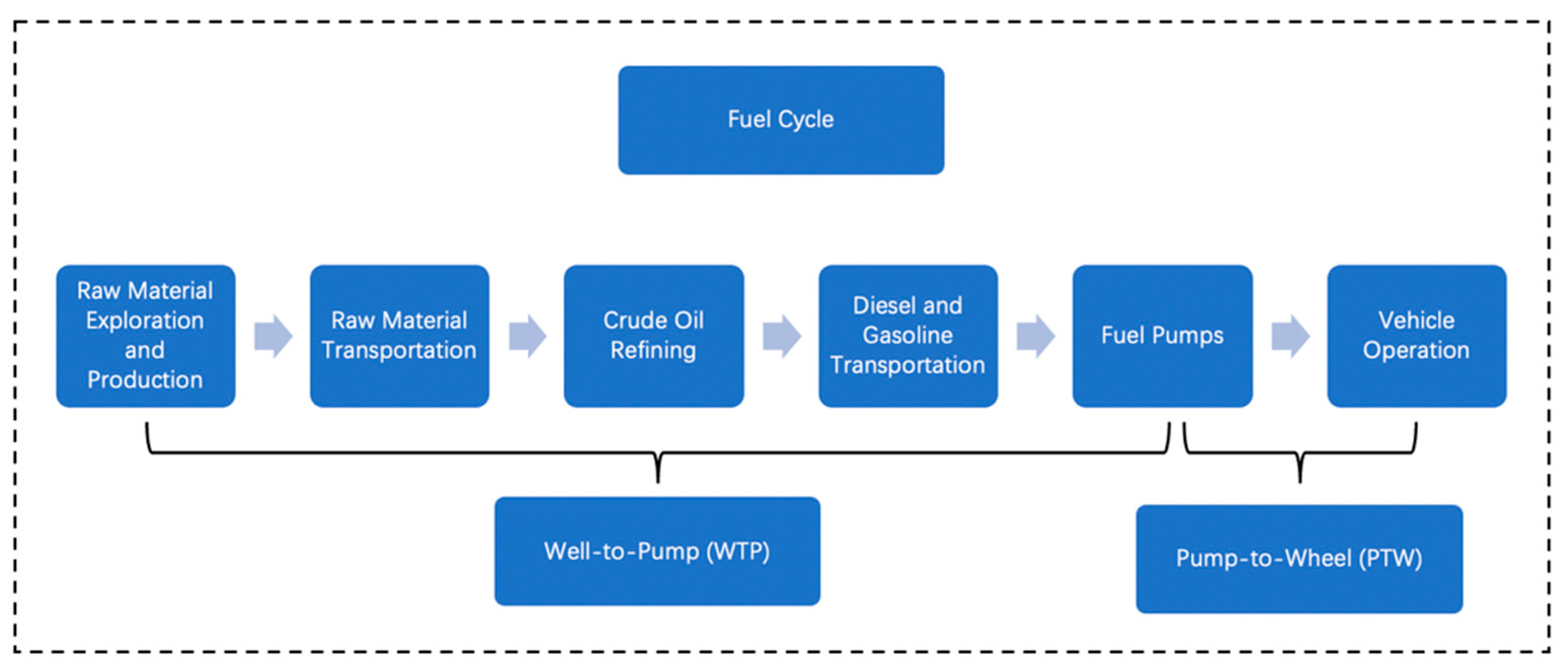
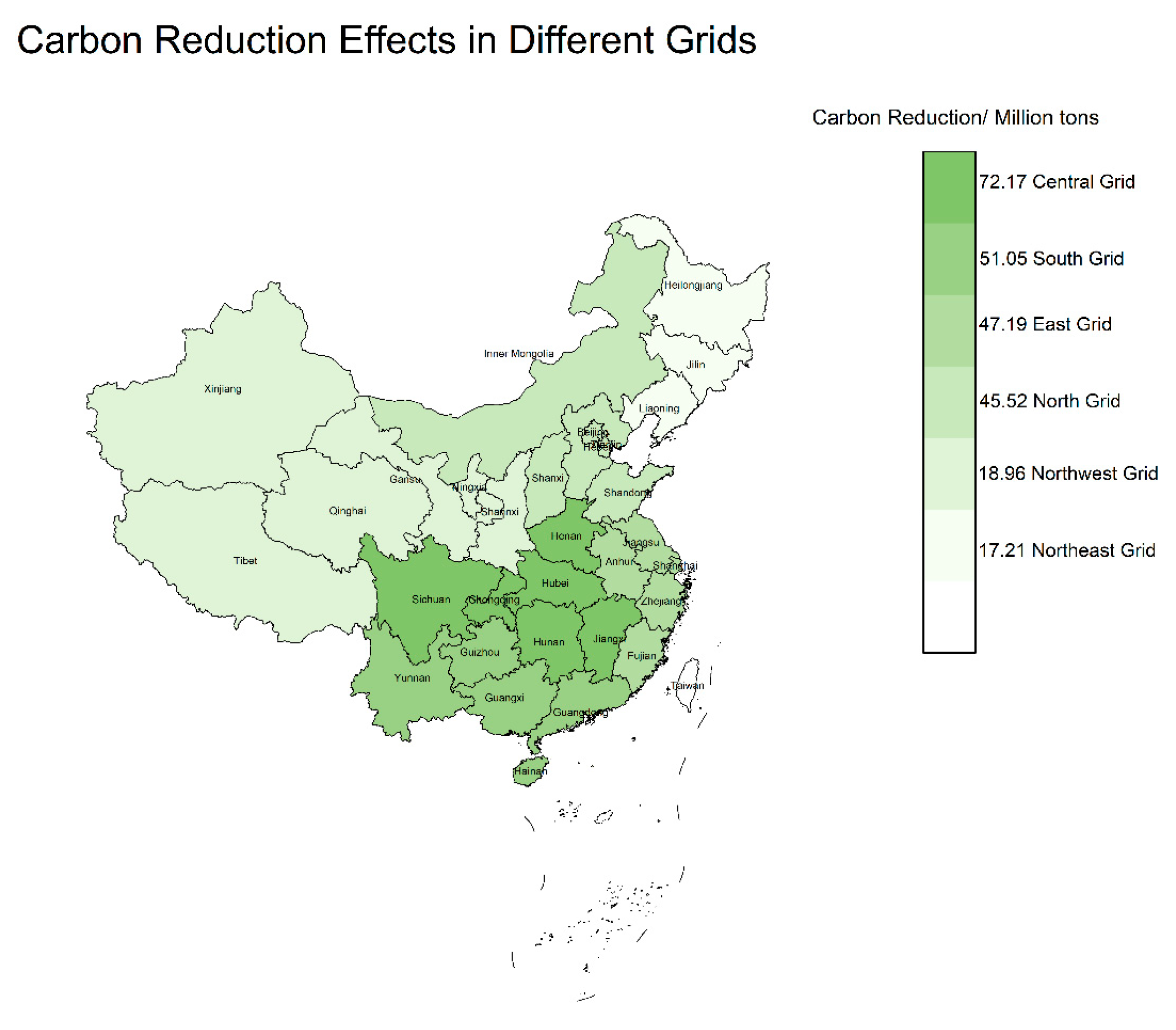
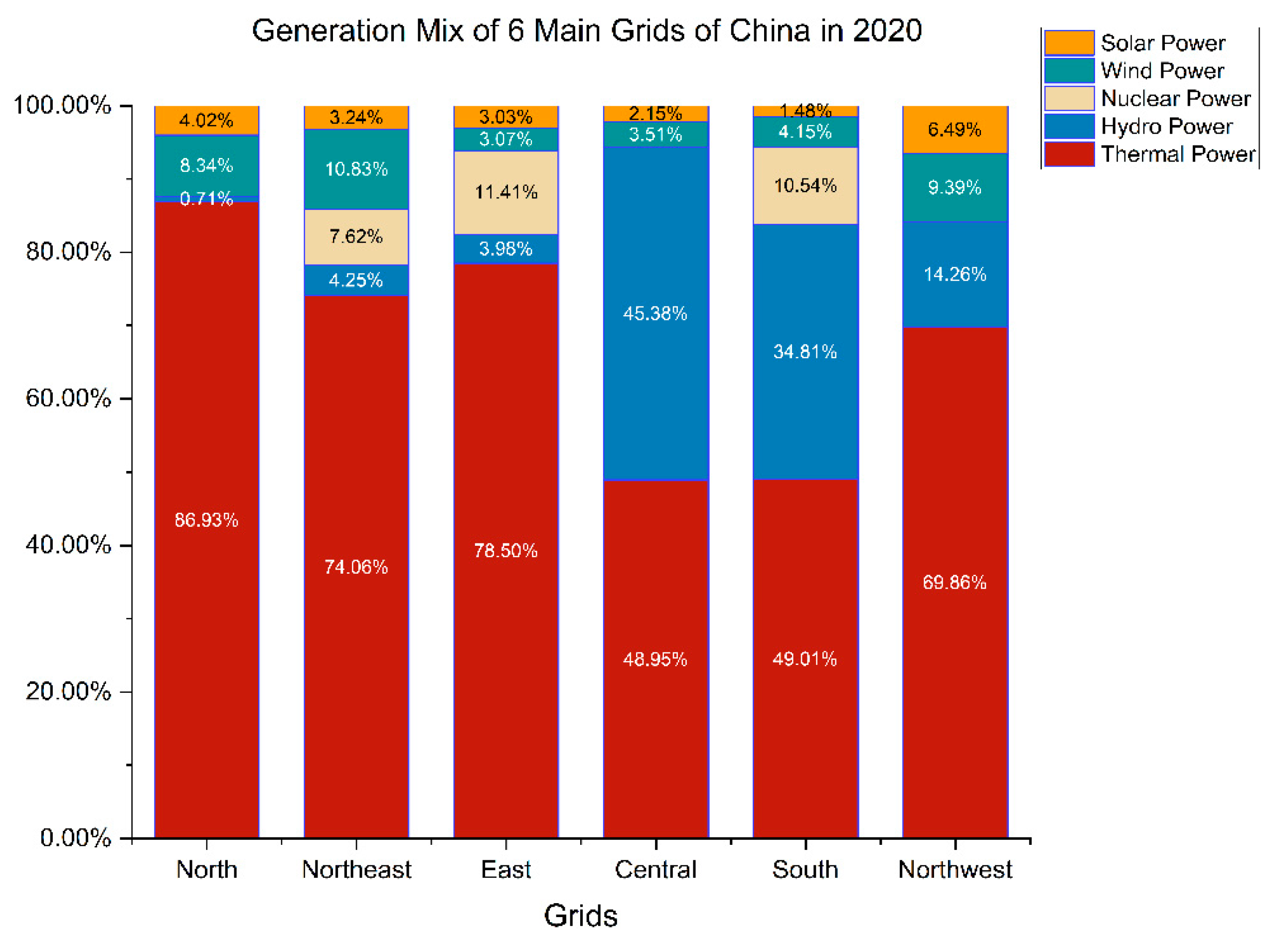

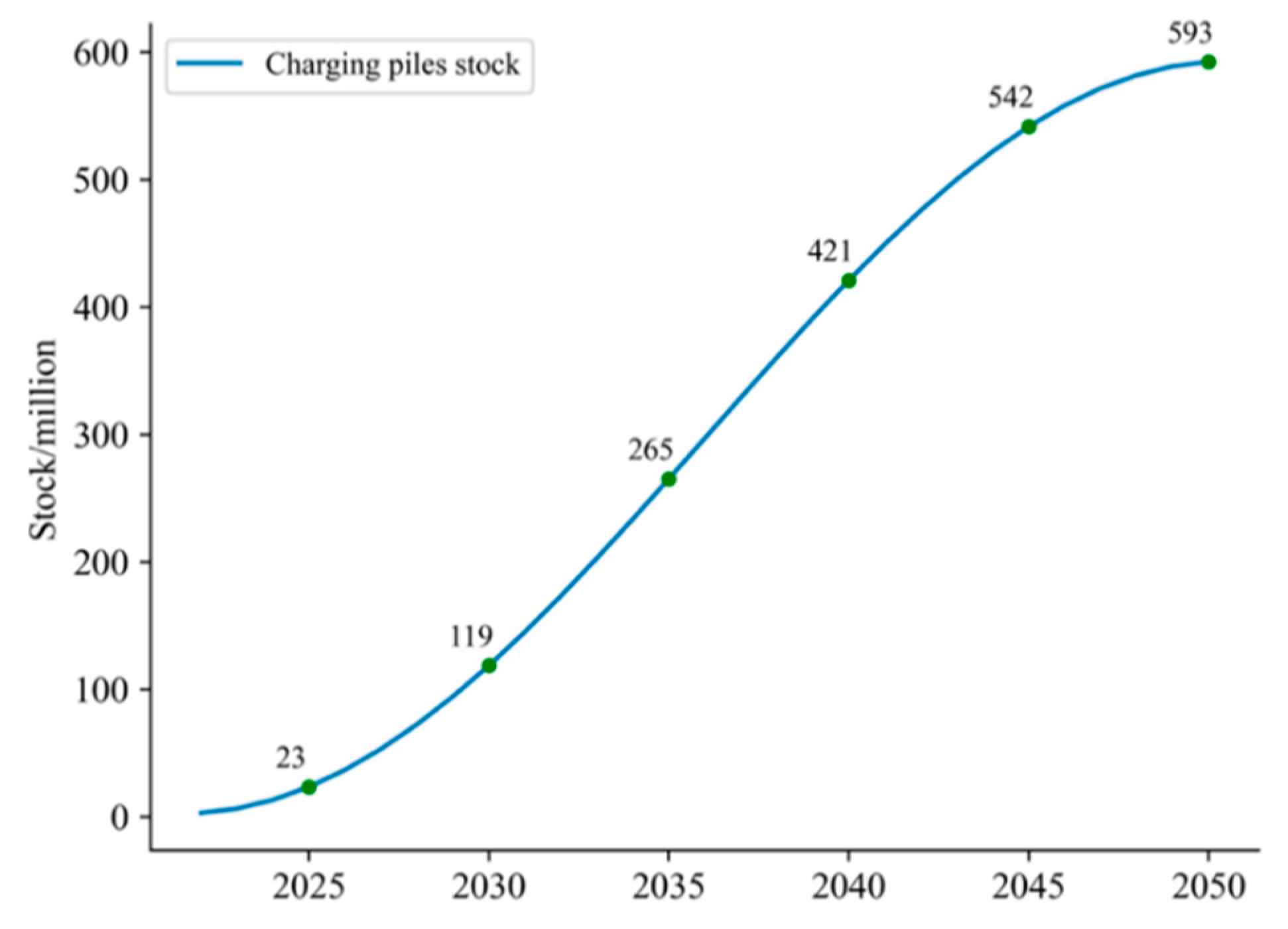
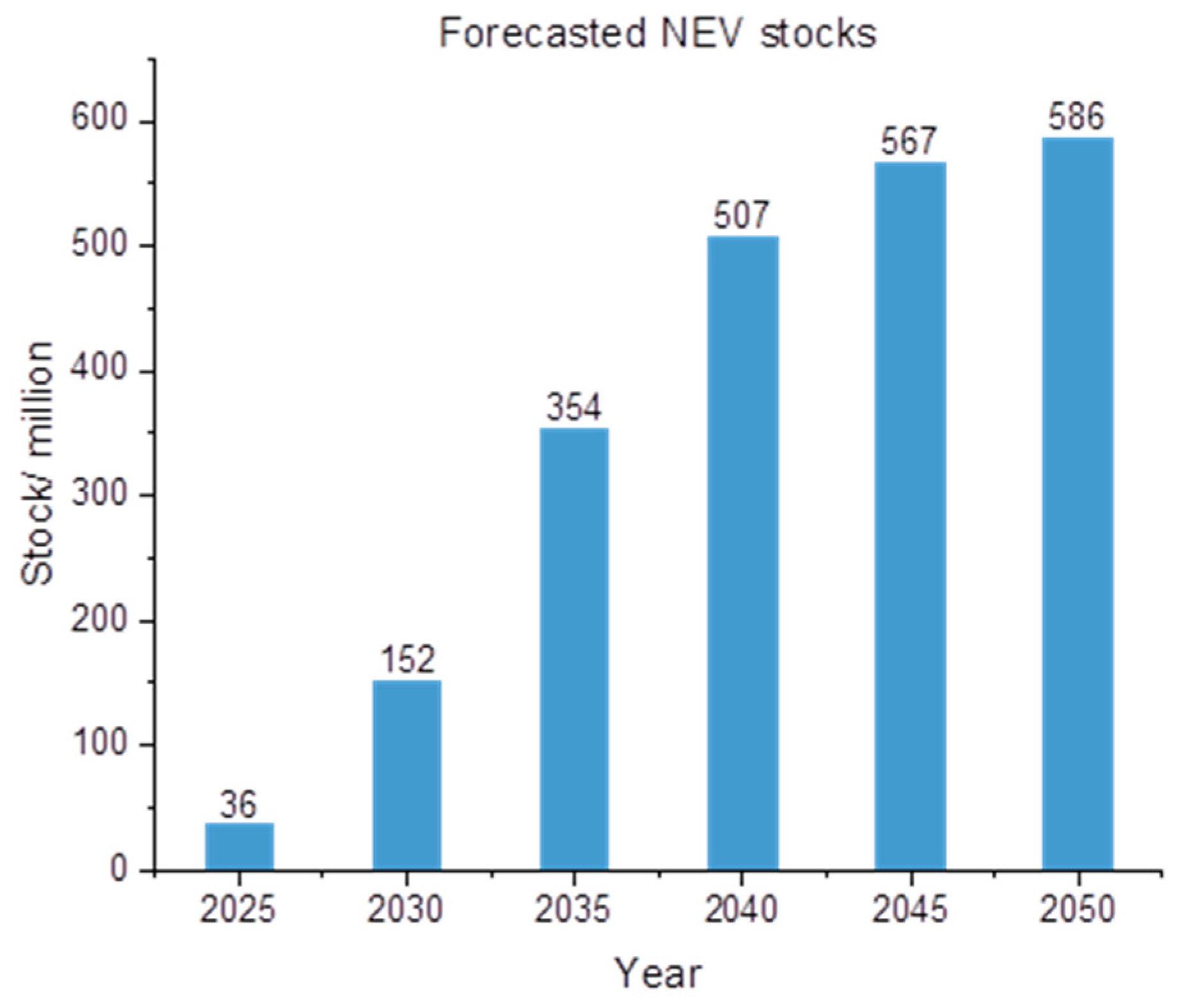
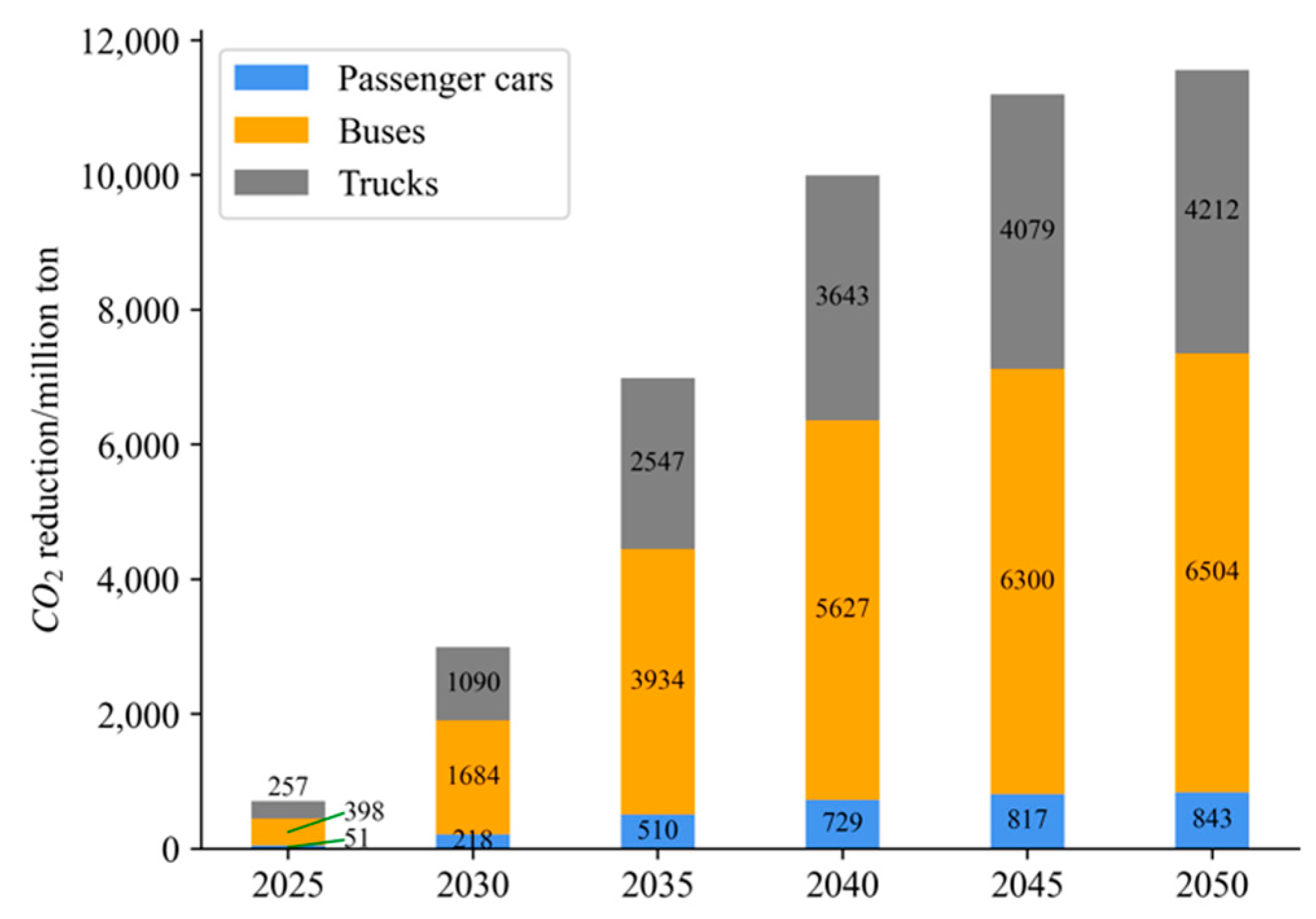
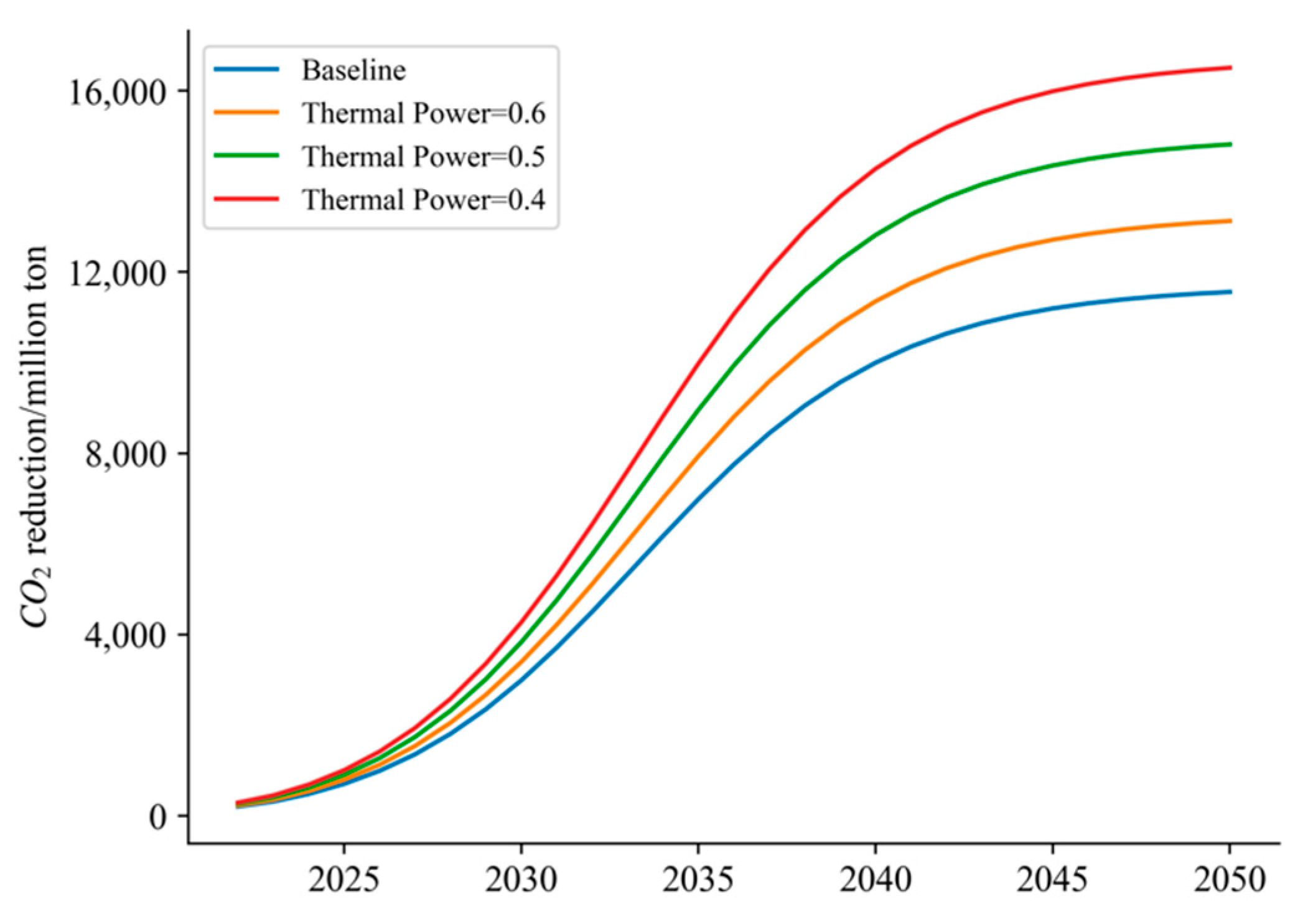

| Criteria | Indicator | Source |
|---|---|---|
| Social Economic Data | Gross Domestic Product (GDP) | 2020 China Statistical Yearbook |
| Regional Population | The 7th Population Census in PRC | |
| NEV Stock | Regional Data of NEV Stock | Traffic Administration Bureau of the Ministry of Public Security (TABMPS) |
| NEV Mileage Data | Annual Accumulative Mileage of Different Usage Classifications (Passenger Cars, Buses, and Trucks) | New Energy Vehicle Big Data Research Report |
| Annual Accumulative Mileage of Different Technology Classifications (BEVs, FCVs, and PHEVs) | New Energy Vehicle National Big Data Alliance Briefing | |
| Charging Data | Charging Pile Stocks | China Electric Vehicle Charging Infrastructure Promotion Alliance (EVCIPA) |
| Annual Charging Data of NEVs | China Electric Vehicle Charging Infrastructure Promotion Alliance (EVCIPA) | |
| Energy Source Related Data | Regional Generation Mix | China Energy Statistical Yearbook, 2020 |
| Mining Efficiency | China Statistical Yearbook on Electricity, 2020 | |
| Transmission Efficiency | China Statistical Yearbook on Electricity, 2020 | |
| Power Generation Efficiency | China Statistical Yearbook on Electricity, 2020 |
| NEV Types | Classification Based on Usage | CO2 Emission Reduction (Million Tons) |
| BEV | Passenger cars | 110.65 |
| Buses | 127.62 | |
| Trucks | 48.61 | |
| PHEV | Passenger cars | 5.05 |
| Buses | 5.82 | |
| Trucks | 2.22 | |
| FCV | Passenger cars | 0.16 |
| Buses | 0.18 | |
| Trucks | 0.06 |
| Iteration | Sample Size | Crossover Rate | Mutation Rate |
| 500 | 500 | 0.8 | 0.1 |
Publisher’s Note: MDPI stays neutral with regard to jurisdictional claims in published maps and institutional affiliations. |
© 2022 by the authors. Licensee MDPI, Basel, Switzerland. This article is an open access article distributed under the terms and conditions of the Creative Commons Attribution (CC BY) license (https://creativecommons.org/licenses/by/4.0/).
Share and Cite
Chen, A.; You, S. The Fuel Cycle Carbon Reduction Effects of New Energy Vehicles: Empirical Evidence Based on Regional Data in China. Sustainability 2022, 14, 16003. https://doi.org/10.3390/su142316003
Chen A, You S. The Fuel Cycle Carbon Reduction Effects of New Energy Vehicles: Empirical Evidence Based on Regional Data in China. Sustainability. 2022; 14(23):16003. https://doi.org/10.3390/su142316003
Chicago/Turabian StyleChen, Anqi, and Shibing You. 2022. "The Fuel Cycle Carbon Reduction Effects of New Energy Vehicles: Empirical Evidence Based on Regional Data in China" Sustainability 14, no. 23: 16003. https://doi.org/10.3390/su142316003
APA StyleChen, A., & You, S. (2022). The Fuel Cycle Carbon Reduction Effects of New Energy Vehicles: Empirical Evidence Based on Regional Data in China. Sustainability, 14(23), 16003. https://doi.org/10.3390/su142316003





